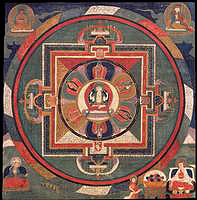
introduction
Statement of Purpose:
There are more thangkas on view at tibetart.com than there are
presently on display in all the museums in the western world. Most of
the thangkas remaining in the world are now outside Tibet. The
majority reside in private or museum collections where many are kept
in storage, unavailable for study or enjoyment. This website seeks to
turn this tide of exclusion by opening its virtual halls to all.
tibetart.com will make thangkas available to scholars, lay people
and religious practitioners. When fully developed, tibetart.com will
provide scholarly forums and guided tours in addition to the
opportunity to search an extensive database of thousands of thangkas
dispersed around the world. In addition, the web site will contain
information and commentary on the historical and religious
significance of the thangkas and the iconographic and aesthetic
traditions which gave birth to them. New descriptions are being added
weekly by scholars internationally.
We extend an invitation to all collectors of Himalayan thangkas both
private and institutional to display your images at tibetart.com.
Through our combined efforts a culture in Diaspora can be preserved
and these beautiful and profound art objects made available to a
broader audience than has ever been possible before.
We invite your suggestions in response to the site. Email:
info@tibetart.com.
Origins of Tibetan Art
Tibetan Art can only be understood in the context of its sacred
Buddhist origins. The ancient King Srong Tsen Gampo unified the
then non-Buddhist country we now know as Tibet in the 7th century.
Establishing one of the largest empires in the history of mankind,
his domain stretched from Afghanistan to Xian, the capital of
China. King Srong demanded wives from the courts of his closest
neighbors, the Buddhist kingdoms of China and Nepal. It is the works of art that these two princesses brought with
them to Tibet that form the sacred seeds of the origins of Tibetan
art. The Chinese princess Wen Ju brought a pair of ancient life-size
sandalwood Indian statues of the Buddha said to have been made
as portraits during the lifetime of Shakyamuni Buddha. This statue was brought as an offering by Srong tsen gampo's Nepalese
wife, the Nepalese princess Brikuti. From these origins Buddhism
was established firmly over the next hundred years culminating
when the King Tri Srong De Tsen in the 8th century attempted to
lay the foundation for the first monumental temple and monastery
in Tibet at Samye. Local spirits were disturbed by these religious activities and
the greatest tantric Buddhist adept in India, Guru Rinpoche Padmasambava
was invited by the king to subjugate these spirits. Guru Rinpoche in many manifestations was completely successful
not only taming the local spirits but converting them to the protectors
of Buddhism in Tibet as well. Padmasambava was predicted by Buddha
Shakyamuni, and he taught the highest innermost Vajrayana Buddhist
teachings to the King and other Tibetan students. Little remains of this early period when Buddhism and the building
of temples and the attendant art and artifacts prospered for nearly
a hundred years. Mid-way through the 9th century the despot Langdarma
murdered his elder brother the Buddhist king Rapalcen and usurped
the throne in an anti-Buddhist campaign. Then Buddhism and its
artistic forms were violently purged. In a cultural brain wishing
campaign not unlike the violent purges of Buddhist antiquities
during the Chinese Cultural Revolution of the 1960's and 70's
in Tibet when 6000 monasteries were destroyed and sacred bronze
and painted images were desecrated, the despot Langdarma destroyed
any artistic expressions of monastic or public Buddhism in any
form. After a brief and destructive reign he was assassinated
by the Buddhist monk Lha Lung Pelki Dorje. At this point the centralized
empire of Tibet fell back into disparate feudal states breaking
up into small often warring enclaves. A dark age ensued for over
150 years. Then, in a small kingdom in Western Tibet (Tib: Ngari),
under the kingship of Yeshe O, Buddhism and its attendant art
forms of architecture, sculpture, and painting were totally revived.
King Yeshe O had sent 21 promising young monks in 950 to study
in the monastic Collages in India with the aim for them to return
to their homeland to establish centers of buddhist learning. The
tropical climate killed all but two monks, one Rinchen Zangpo
completed his studies and returned with a band of Indian master
artists decades later. Living well past the age of 100 he established
at least 21 temples and translation centers in Western Tibet.
What we see remaining of these temples frescoes, some of which
are now preserved in temples in the Indian Himalayas, reflects
the fluorescing of Indian, particularly Kashmiri Buddhist art
before dying out completely under wave after wave of Moslem invasions
(not one painting on cloth of this period remains in India!).
Along with paintings and statues of Buddhas which take many forms,
both human and fantastic and male and female we find surviving
frescoes of mandalas. Mandala paintings are two dimensional representations of the multidimensional
universes these Buddhas inhabit. Mandalas are not to be understood
as representing someplace different from where we are right now
. Rather mandalas display an Enlightened ever present world that
is revealed when the dualities of anger, attachment and ignorance
are stripped away. Actually these enlightened worlds are constructed
of these very same energies that in our dualistic view we perceive
as anger, attachment and ignorance but in the unencumbered enlightened
state these same defiled emotions manifest as strength, compassion
and wisdom. In this sense mandalas are much like architectural
blueprints or aerial views of celestial palaces constructed of
enlightened concepts. For example, mandalas are usually laid out
on a compass like grid; the western quadrant appears red representing
the transmutation of desire into discriminating wisdom. The surviving frescoes of mandalas of these mediation cycles (sanskrit:
tantras) that were translated and transmitted by Rinchen Zangpo
in Western Tibet convey the vivid confidence the artists at the
time had in Buddhist practice. The almost erie use of chiaroscuro
conveys a palpable mystical presence to the deities and their
enlightened settings. These Buddha's are shown clothed in silks
who designs give us a distinct time frame to date the paintings.
Over the centuries Buddhism took hold throughout Tibet. The artistic
traditions of India and later the styles of Nepal and eventually
China influenced Tibetan art. Exquisite Buddha images were caste
using alloys whose production was of alchemical proportions. Even
today Tibetan bronzes of the early period display inexplicably
beautiful patinas. Tibetan culture is at a crossroads now. We are left to sort through
the few remnants of Tibetan art history left over from the treasure
trove that was destroyed during the Chinese Cultural
Revolution in Tibet. As the scholar David Jackson has said "One of the
most serious problems facing historians of Tibetan art is the fact that
the sacred artworks have been since the 1960s uprooted and scattered far and
wide. Although many paintings were originally parts of multi-thangka sets, now
they often hang alone somewhere in the West as single paintings... One basic
task of the researcher is to try to discover the lost order in this chaos..."
Through the participation of private and public collections world wide
in tibetart.com we can reassemble if not physically than at least
virtually the remaining artworks and give access to people all
over the world to the knowledge and aesthetics of one of the last
surviving ancient wisdom traditions.
The Himalayan Art Project
of the Shelley and Donald Rubin Foundation
has as its goal to preserve the sacred Buddhist art of the
Himalayas.This art emanates from the sacred traditions around which
the profound and ancient cultures of Tibet and its neighbors have
flourished over the last thousand years.
- Moke Mokotoff
- Moke Mokotoff 2/98
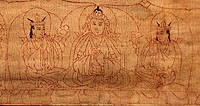
The 7th Century king of Tibet, Srong Tsen Gampo and his two Queens
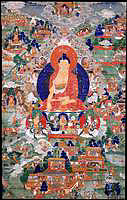
Buddha Shakyamuni
The most highly venerated and important work of art, the Jo rinpoche
now enshrined in the Jokhang Temple in Lhasa is one of these.
This statue was the most common object of pilgrimage whereby 100s
of thousands of Tibetans over the centuries walked and sometimes
prostrated thousands of miles to venerate this icon. The next
most important image in Tibet was the sandalwood image of Avalokiteshvara,
the patron bodhisattva of the land of snows. The mantra of Avalokiteshvara is Om Mani Padme Hum.
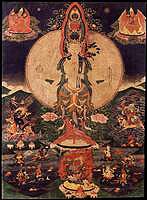
The 8th century king, Tri Srong Detsen invited Padmasambava to
Tibet
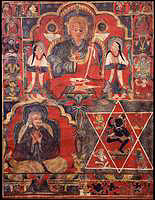
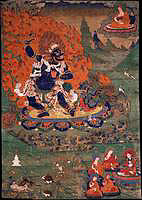
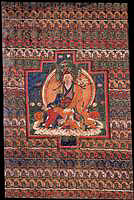
Guru Rinpoche took many manifestations in Tibet
![]()
Readily available books:
Mystic Art of Ancient Tibet
Blanche Olschak and Geshe Thupten Wangyal, Mc Graw - Hill, 1973Tibet a Lost World
Valerie Reynolds, Newark Museum, 1978Tibetan Art
P. Pal, LA County Museum 1988Tibetan Thangka Painting
David and Janice Jackson, ill. by Robert Beer, Serindia London 1984Wisdom and Compassion
Robert Thurman and Marilyn Rhie, Abrams
